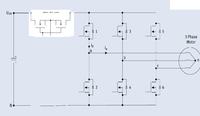Electro nS
Full Member level 6
hi
i have learned through experiments in power electronics and working with N channel mosfets
that when you design a converter/controller in half/full bridge topology , you choose the VDS rating to be 2x Vcc (for inductive loads) , because of transients and such staff.
now my question do i have to use the same overrating if i am using this mosfet in Solid state relay configuration ?? here i will turn on once the device (ex 3 phase inverter) is on , and off after operation is finished , so now frequent switching on this device ...
so does the mosfet in the SSR effects by the transisent as the mosfets in the bridge ??? should all of them have the same Vds ??
info: circuit voltage is 24-28v , mosfets in brige are 60v vds , in ssr i am "hoping" to use 40v mosfet , please advise !!! see attached circuit

i have learned through experiments in power electronics and working with N channel mosfets
that when you design a converter/controller in half/full bridge topology , you choose the VDS rating to be 2x Vcc (for inductive loads) , because of transients and such staff.
now my question do i have to use the same overrating if i am using this mosfet in Solid state relay configuration ?? here i will turn on once the device (ex 3 phase inverter) is on , and off after operation is finished , so now frequent switching on this device ...
so does the mosfet in the SSR effects by the transisent as the mosfets in the bridge ??? should all of them have the same Vds ??
info: circuit voltage is 24-28v , mosfets in brige are 60v vds , in ssr i am "hoping" to use 40v mosfet , please advise !!! see attached circuit
